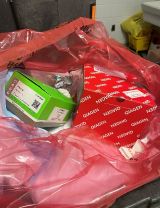Are BSL-1 materials considered red bag wastes?
If these wastes have been inactivated, they are considered regular trash. Most inactivation can be accomplished with 10% bleach and appropriate contact time or washing with soap and water (in the case of PPE, such as gloves). PPE that was not exposed to your working materials would be considered trash.
How does a material meet the definition of regulated waste?
It is considered red bag waste if it drips or releases blood or other potentially infectious materials when compressed. For example, consider a saturated, bloody gauze vs. a used band-aid from a minor laceration. The gauze would be considered a regulated material and require red bag disposal. The band-aid, while likely to contain some blood from the cut, would be able to retain the liquid volume without releasing it. This band-aid would be regular trash.
Is PPE contaminated with chemicals suitable to dispose of in a red bag? What about small amounts of chemicals?
No, and no. If PPE is exposed to acute toxics or HHOPs, it should be collected separately and submitted as chemical waste for pickup by EHS. Chemicals should always be collected and submitted to EHS for removal via Salute. Some biological liquids, <10mL, are acceptable for red bag disposal if properly contained.
Is all PPE used in clinical procedures considered red bag waste?
No. Most PPE from routine and non-emergency procedures are acceptable to place in regular trash. However, bloodied gloves, masks, gowns, etc., would be considered red bag waste.

Example of materials suitable for trash disposal found in red bag waste

Chemical kits improperly disposed in red bag waste

